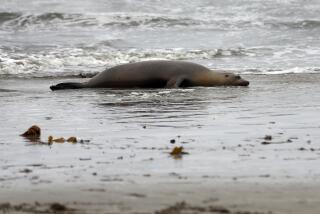In wake of drought and fires, turtle habitat becomes death trap
Reporting from ELIZABETH LAKE, Calif. — Biologists strode along the cracked, dry mud surrounding this evaporating north Los Angeles County lake last week, pausing periodically to pick up an emaciated turtle and wash alkaline dust off its head and carapace.
“A lot of these animals are severely ill and starving,” said Tim Hovey, a state Department of Fish and Wildlife biologist, as he gestured toward a group of turtles bobbing in the murky water offshore.
After three years of drought, this natural 2-mile-long lake, about 15 miles west of Lancaster, has become a smelly, alkaline death trap for one of the largest populations of state-protected Western pond turtles in Southern California.
Many of the lake’s estimated 300 turtles — shy, aquatic reptiles that are 4 to 8 inches long and live to be 60 years old — are gathering along the receding shoreline with nothing to eat, no place to take refuge and “looking like they’ve been dipped in wet cement,” U.S. Geological Survey biologist Jeff Lovich said.
Occasional turtle die-offs are natural, but some biologists suggest the magnitude of this event may have been exacerbated by the water drawn from the drought-stricken lake to fight the devastating Powerhouse fire, which destroyed dozens of homes and scorched thousands of acres in the area last year.
The turtles’ plight was discovered in August during an environmental survey conducted by consultants working on behalf of some of the scores of people who are suing the Los Angeles Department of Water and Power alleging the utility is responsible for the fire and failed to properly maintain power lines and equipment.
Preliminary results of necropsies conducted on five turtle carcasses at the U.S. Geological Survey’s National Wildlife Health Center in Madison, Wis., suggest they died of diseases and conditions related to starvation, said David Green, an amphibian pathologist at the center.
The situation is not unprecedented. Elizabeth Lake, which is fed by stormwater, dried up in the mid-1960s and again in the early 1990s, wiping out aquatic life, including pond turtles. In both instances, the species somehow managed to recolonize the lake.
What sets the current crisis apart is an ongoing effort to save as many of the turtles as possible and to protect their genetic makeup.
Genetic sampling indicates the turtles are unique because they contain genetic material of both northern and southern populations of the Western pond turtle, said Robert Fisher, a USGS biologist.
In a collaborative rescue operation led by the California Department of Fish and Wildlife, the USGS, the U.S. Forest Service and the biological consulting firm Ecorps, 30 turtles were captured in September and transported to the nonprofit Turtle Conservancy’s Behler Chelonian Center in Ventura County.
“The turtles we took in are eating with vigor and bouncing back,” said Paul Gibbons, managing director of the center and a reptile veterinarian certified by the American Veterinary Medical Assn. “They’ll stay with us until it rains. After that, they’ll be returned to the lake.”
An unknown number of turtles has perished in the lake, part of a chain of wetlands along the San Andreas Fault. The western half of the lake is owned and managed by the U.S. Forest Service. The eastern half is privately owned.
A team of state biologists has been monitoring the turtles on a daily basis, and weighing offers from institutions such as the San Diego Zoo and UCLA to provide temporary housing for dozens more of the ailing reptiles.
Complicating the search for caretakers is the concern that salvaged turtles might escape their temporary quarters and join local populations elsewhere, altering the genetic lineage.
The Western pond turtle — California’s only native freshwater turtle — was already in dire straits due to urbanization, which has consumed much of its habitat.
Once common in streams and lakes from the Canadian border to Baja, Mexico, the turtle is listed as endangered in Oregon and Washington and as a “species of special concern” in California because of its dwindling population. The species has been proposed for federal listing.
Armed with long-handled nets, water testing equipment and binoculars, Hovey and Gibbons recently walked the perimeter of the lake, which seemed to be on the verge of ecological collapse.
Salinity levels at the lake range from 31 to 43 parts per thousand parts of water, Gibbons said. The salinity level of the Pacific Ocean is about 35 parts per thousand.
Ravens poked at the remains of dead animals along the water’s edge. Myriad fresh tracks winding from the shoreline to higher ground indicate that the healthier turtles have been seeking hibernation sites earlier than usual this year.
“It pulls on our heart strings to see large numbers of animals that are weak, starving and behaving strangely,” Gibbons said. “But wild populations sometimes get stronger by adapting to harsh conditions.”







